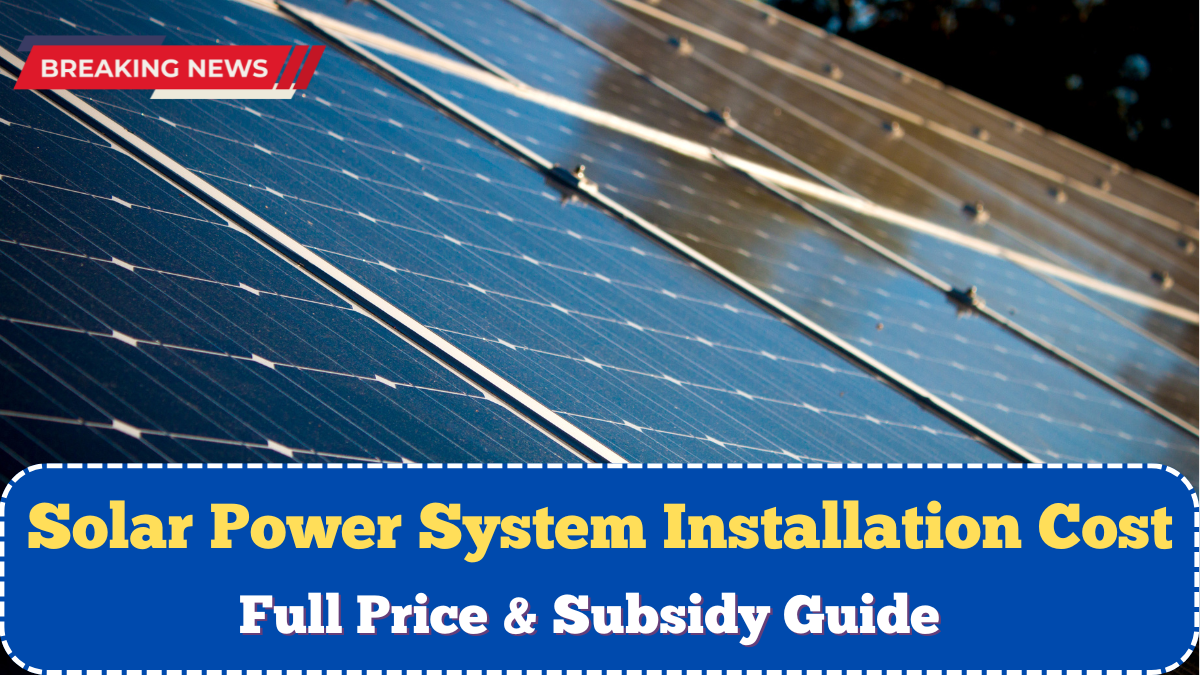With rising electricity prices and increasing environmental awareness, homeowners in 2025 are actively switching to solar energy. The solar power system installation cost 2025 has become a hot topic as more people seek clean, affordable, and long-term energy solutions. Solar panels are no longer luxury additions but a smart investment backed by government support and improved technology.
In 2025, installing a solar system at home isn’t just about saving electricity—it’s about sustainability, independence, and reducing carbon footprints. This article provides a detailed look into the costs, subsidies, and options available this year to help you make the best decision.

Average Installation Cost Breakdown in 2025
The solar power system installation cost 2025 depends on various factors including the size of the setup, location, type of panels, and available government subsidies. Here’s a quick cost breakdown:
| System Size | Average Cost (Before Subsidy) | Government Subsidy | Final Cost (After Subsidy) |
|---|---|---|---|
| 1 kW | ₹75,000 – ₹90,000 | Up to ₹18,000 | ₹57,000 – ₹72,000 |
| 3 kW | ₹2.2L – ₹2.7L | Up to ₹54,000 | ₹1.7L – ₹2.2L |
| 5 kW | ₹3.8L – ₹4.5L | Up to ₹75,000 | ₹3.05L – ₹3.75L |
| 10 kW | ₹7.5L – ₹9L | Up to ₹1,00,000 | ₹6.5L – ₹8L |
This table shows that solar installations in 2025 are more affordable than ever due to increasing production, better efficiency, and strong renewable energy policies.
Factors Affecting Solar Setup Prices
The final solar power system installation cost 2025 also varies based on specific home requirements and technical components:
-
Type of solar panel: Mono PERC, Polycrystalline, or Thin Film
-
Inverter brand and battery backup options
-
Location-specific rates (urban vs rural)
-
Mounting structure and installation complexity
-
Net metering connectivity costs
By working with certified solar providers, customers can get customized setups that meet both energy needs and budget.
Government Subsidies and Financial Support
In 2025, both central and state governments are actively supporting renewable energy through subsidies, making it easier for homes to go solar. The official rooftop solar subsidy scheme (such as the updated PM Surya Ghar Yojana) covers:
-
Up to 40% subsidy for systems below 3 kW
-
Up to 20% subsidy for systems between 4–10 kW
-
Direct bank transfer of subsidy amount after installation
-
EMI and loan options from recognized solar vendors
This substantial financial support significantly reduces the solar power system installation cost 2025 and increases the return on investment within 4–6 years.
Why 2025 Is the Best Year to Go Solar
Installing a solar system in 2025 offers unmatched value. Here’s why:
-
Lower installation prices compared to previous years
-
Better-performing solar panels with longer warranties
-
Wider availability of government-approved vendors
-
Seamless application process for subsidies and net metering
-
Higher savings due to reduced electricity bills and energy independence
Families switching to solar in 2025 are seeing monthly savings of ₹2,000–₹4,000 depending on usage. The long-term financial and environmental impact is substantial.
FAQs
What is the average solar power system installation cost 2025?
In 2025, the average cost ranges between ₹75,000 for small systems and ₹9 lakhs for larger home systems, depending on size, brand, and location.
Are there government subsidies available in 2025?
Yes, government subsidies under national schemes can cover up to ₹1 lakh for rooftop installations, directly reducing the solar power system installation cost 2025.
How long does it take to recover the installation cost?
Most homeowners recover their full investment in 4–6 years due to reduced electricity bills and net metering benefits.
Do all homes qualify for solar subsidies in 2025?
Subsidies are available for residential consumers installing grid-connected systems through registered vendors and fulfilling government norms.
What is included in the installation cost?
The solar power system installation cost 2025 usually includes solar panels, inverter, mounting structures, wiring, installation labor, and net metering setup.
Click here to know more.
